
|
Now it is 6.4 mag (Jan. 1, Neil Norman). It was expected to brighten up to 4-5 mag from autumn to winter. But actually, it is 6 mag at best. In the Northern Hemisphere, it will be observable in excellent condition after this. In the Southern Hemisphere, it is hardly observable after this.
Date(TT) R.A. (2000) Decl. Delta r Elong. m1 Best Time(A, h)
Jan. 2 14 13.47 20 4.3 0.880 1.192 79 5.4 5:37 (294, 61)
Jan. 9 14 7.37 34 13.1 0.775 1.281 92 5.3 5:38 (269, 74)
|

|
It brightened very rapidly. Now it is so bright as 8.8 mag (Dec. 29, Neil Norman). It is observable at 9-10 mag until spring in excellent condition in the Northern Hemisphere. It keeps unobservable in the Southern Hemisphere.
Date(TT) R.A. (2000) Decl. Delta r Elong. m1 Best Time(A, h)
Jan. 2 16 56.36 61 58.2 1.914 2.118 87 8.9 5:37 (215, 40)
Jan. 9 16 56.48 62 17.0 1.906 2.131 89 8.9 5:38 (214, 44)
|
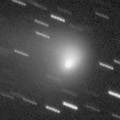
|
Now it is so bright as 9.2 mag (Dec. 30, Marek Biely). It will pass close to the earth from spring to summer, and it is expected to be observable at 5-6 mag in good condition. It is observable in excellent condition in the Northern Hemispehre. In the Southern Hemisphere, it is not observable from mid January until early April.
Date(TT) R.A. (2000) Decl. Delta r Elong. m1 Best Time(A, h)
Jan. 2 0 4.71 21 20.2 1.811 2.048 89 9.2 18:29 ( 53, 69)
Jan. 9 23 55.31 18 26.0 1.912 1.977 79 9.1 18:34 ( 64, 60)
|
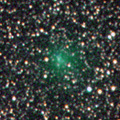
|
It brightened very rapidly. Now it is bright as 9.2 mag (Nov. 30, Juan Jose Gonzalez). It keeps 11-13 mag until February. But it keeps very low.
Date(TT) R.A. (2000) Decl. Delta r Elong. m1 Best Time(A, h)
Jan. 2 21 43.22 -20 34.6 2.107 1.507 40 12.0 18:29 ( 51, 15)
Jan. 9 22 6.19 -18 59.5 2.159 1.533 39 12.2 18:34 ( 53, 15)
|
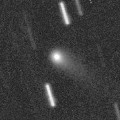
|
Now it is bright as 12.2 mag (Dec. 19, Uwe Pilz). It keeps 12 mag for a long time from 2015 autumn to 2016 summer. In the Northern Hemispehre, it keeps observable in good condition for a long time. It keeps unobservable in the Southern Hemisphere.
Date(TT) R.A. (2000) Decl. Delta r Elong. m1 Best Time(A, h)
Jan. 2 19 27.86 72 27.3 2.488 2.765 95 12.2 18:29 (159, 34)
Jan. 9 19 41.51 70 25.0 2.518 2.747 92 12.1 18:34 (157, 32)
|
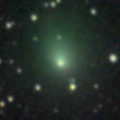
|
Now it is bright as 9.7 mag (Nov. 30, Juan Jose Gonzalez). It is already unobservable in the Southern Hemisphere. It will be unobservable soon also in the Northern Hemisphere.
Date(TT) R.A. (2000) Decl. Delta r Elong. m1 Best Time(A, h)
Jan. 2 20 46.38 -19 18.3 2.509 1.705 28 12.2 18:29 ( 61, 7)
Jan. 9 21 6.86 -18 5.4 2.564 1.734 25 12.4 18:34 ( 64, 5)
|
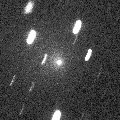
|
New bright comet. Now it is 12.8 mag (Dec. 19, Michael Jager). It looks diffuse visually. It is observable in excellent condition in the Northern Hemisphere. It keeps 13 mag within December, but it will be fading rapidly after January. It is not observable in the Southern Hemisphere.
Date(TT) R.A. (2000) Decl. Delta r Elong. m1 Best Time(A, h)
Jan. 2 10 53.95 66 8.1 0.827 1.587 122 12.8 4:14 (180, 59)
Jan. 9 8 2.00 75 0.3 0.864 1.653 126 13.1 1:04 (180, 50)
|

|
It brightened up to 3.7 mag and became a naked eye comet in mid January in 2015 (Jan. 13, Marek Biely). Now it is fading. But it is bright as 12.5 mag still now (Dec. 9, Thomas Lehmann). In the Northern Hemisphere, it keeps observable for a long time until the comet fades out. It is not observable until March in the Southern Hemisphere.
Date(TT) R.A. (2000) Decl. Delta r Elong. m1 Best Time(A, h)
Jan. 2 17 51.38 20 7.9 5.027 4.390 45 13.3 5:37 (257, 17)
Jan. 9 17 57.26 20 0.7 5.076 4.458 46 13.4 5:38 (260, 22)
|
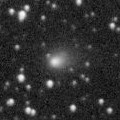
|
Now it is 13.2 mag (Dec. 29, Chris Wyatt). It will brighten up to 11 mag from spring to summer. In the Northern Hemisphere, it keeps observable in good condition while the comet will be brightening. It locates somewhat low in the Southern Hemisphere.
Date(TT) R.A. (2000) Decl. Delta r Elong. m1 Best Time(A, h)
Jan. 2 5 22.02 19 14.6 1.480 2.427 159 13.7 22:35 ( 0, 74)
Jan. 9 5 15.18 19 18.1 1.476 2.385 151 13.5 22:01 ( 0, 74)
|

|
Now it is 14.3 mag (Dec. 8, Yuji Ohshima). It will brighten up to 13 mag from winter to spring. It will be observable in excellent condition in the Southern Hemisphere. But it locates somewhat low in the Northern Hemisphere.
Date(TT) R.A. (2000) Decl. Delta r Elong. m1 Best Time(A, h)
Jan. 2 14 12.04 -12 40.7 2.401 2.188 65 13.9 5:37 (326, 35)
Jan. 9 14 24.45 -13 51.6 2.327 2.187 69 13.8 5:38 (331, 36)
|

|
Now it is 13.3 mag (Dec. 8, Hiroshi Abe). It will be fading slowly after this. In the Northern Hemisphere, it keeps observable in good condition. It will be getting higher gradually after this also in the Southern Hemisphere.
Date(TT) R.A. (2000) Decl. Delta r Elong. m1 Best Time(A, h)
Jan. 2 12 18.49 7 23.9 1.620 2.028 99 13.9 5:35 ( 0, 62)
Jan. 9 12 21.88 7 22.8 1.589 2.082 105 14.0 5:11 ( 0, 62)
|

|
It is not observable now. It will appear in the morning sky in February.
Date(TT) R.A. (2000) Decl. Delta r Elong. m1 Best Time(A, h)
Jan. 2 18 39.15 -27 41.1 6.955 5.976 5 14.0 5:37 (291,-19)
Jan. 9 18 45.47 -27 32.0 6.943 5.974 9 14.0 5:38 (294,-15)
|
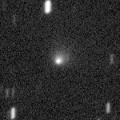
|
It keeps brightening even after the perihelion passage. Now it is 13.0 mag and visible visually (Dec. 21, Juan Jose Gonzalez). It keeps observable in excellent condition for a while. But it will be fading after this.
Date(TT) R.A. (2000) Decl. Delta r Elong. m1 Best Time(A, h)
Jan. 2 5 6.31 9 19.9 0.619 1.559 152 14.6 22:20 ( 0, 65)
Jan. 9 5 7.85 12 32.5 0.661 1.582 147 14.8 21:54 ( 0, 68)
|

|
Now it is 14.8 mag (Nov. 22, Catalina Sky Survey). Distant object, but it keeps observable at 14-15 mag for a long time from 2015 to 2016.
Date(TT) R.A. (2000) Decl. Delta r Elong. m1 Best Time(A, h)
Jan. 2 21 55.73 -7 19.5 5.602 4.997 47 14.7 18:29 ( 58, 27)
Jan. 9 22 2.07 -7 3.9 5.669 4.986 42 14.7 18:34 ( 63, 22)
|
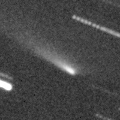
|
Appearing in the evening sky. Now it is bright as 12.0-12.5 mag (Dec. 8, Michael Jager). It tends to brighten very rapidly around the perihelion passage. It will fade out very rapidly after this.
Date(TT) R.A. (2000) Decl. Delta r Elong. m1 Best Time(A, h)
Jan. 2 22 14.25 -7 35.1 1.040 0.889 52 14.8 18:29 ( 54, 30)
Jan. 9 23 0.17 -3 46.7 1.091 0.992 56 15.6 18:34 ( 54, 35)
|
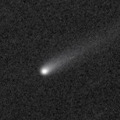
|
It brightened very rapidly in 2015 spring, and reached up to 13.8 mag (May 11, Sandor Szabo). It is bright as 15.5 mag still now (Dec. 20, Jean-Francois Soulier). It keeps 15-16 mag for a while until spring. It is observable in excellent condition in the Southern Hemisphere. But it locates somewhat low in the Northern Hemisphere.
Date(TT) R.A. (2000) Decl. Delta r Elong. m1 Best Time(A, h)
Jan. 2 13 46.83 -23 39.2 3.985 3.729 67 15.4 5:37 (338, 28)
Jan. 9 13 52.88 -24 31.9 3.911 3.750 73 15.4 5:38 (344, 29)
|

|
Now it is 15.7 mag (Dec. 19, Y. Sugiyama). It keeps 15-16 mag for a long time until 2016. It keeps observable in excellent condition in the Northern Hemisphere. It keeps unobservable in the Southern Hemisphere.
Date(TT) R.A. (2000) Decl. Delta r Elong. m1 Best Time(A, h)
Jan. 2 3 16.66 74 42.4 4.643 5.226 121 15.5 20:31 (180, 50)
Jan. 9 3 4.10 74 27.6 4.693 5.233 118 15.5 19:51 (180, 50)
|

|
First return of a periodic comet discovered in 2003. Now it is 15.1 mag (Dec. 17, Space Surveillance Telescope, Atom Site). It is brightening very rapidly. It will approach to the earth from autumn to winter, and it will brighten up to 15 mag and observable in excellent condition.
Date(TT) R.A. (2000) Decl. Delta r Elong. m1 Best Time(A, h)
Jan. 2 4 35.15 20 52.0 0.764 1.687 149 15.5 21:49 ( 0, 76)
Jan. 9 4 35.60 24 3.1 0.811 1.702 142 15.7 21:22 ( 0, 79)
|

|
Now it is 15.8 mag (Dec. 7, Yuji Ohshima). In the Northern Hemisphere, it keeps observable after this while the comet will be fading. It will be getting higher gradually after this also in the Southern Hemisphere.
Date(TT) R.A. (2000) Decl. Delta r Elong. m1 Best Time(A, h)
Jan. 2 14 1.63 20 36.1 2.544 2.597 82 15.6 5:37 (297, 64)
Jan. 9 14 8.23 21 0.0 2.510 2.646 86 15.7 5:38 (304, 68)
|
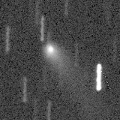
|
Now it is 15.3 mag (Dec. 13, D. Buczynski). It keeps 15 mag for a long time from 2014 to 2015. It is observable in excellent condition in the Northern Hemisphere. It locates low in the Southern Hemisphere.
Date(TT) R.A. (2000) Decl. Delta r Elong. m1 Best Time(A, h)
Jan. 2 0 29.73 45 50.7 4.306 4.634 103 15.8 18:29 (145, 76)
Jan. 9 0 30.75 45 47.4 4.426 4.666 98 15.9 18:34 (133, 72)
|

|
Now it is 15.4 mag (Dec. 8, Yasukazu Ikari). It will be fading slowly after this. In the Northern Hemisphere, it keeps observable for a long time until the comet fades out. In the Southern Hemisphere, it will be unobservable in early January.
Date(TT) R.A. (2000) Decl. Delta r Elong. m1 Best Time(A, h)
Jan. 2 0 6.65 15 32.3 4.232 4.296 87 15.9 18:29 ( 43, 65)
Jan. 9 0 4.37 15 49.8 4.374 4.310 79 16.0 18:34 ( 57, 60)
|

|
It brightened up to 8.8 mag in 2015 spring (Apr. 3, Marco Goiato). Now it is fading. It has already faded down to 15.9 mag (Dec. 15, S. Shurpakov). It keeps observable until March when the comet becomes fainter than 18 mag.
Date(TT) R.A. (2000) Decl. Delta r Elong. m1 Best Time(A, h)
Jan. 2 1 50.24 10 33.3 2.348 2.820 108 16.1 19:05 ( 0, 66)
Jan. 9 1 53.59 11 0.7 2.485 2.862 102 16.3 18:41 ( 0, 66)
|
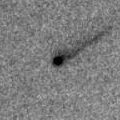
|
Now it is 16.7 mag (Dec. 11, D. Buczynski). It will brighten rapidly after this, and it will be observable at 14-15 mag in good condition from winter to summer.
Date(TT) R.A. (2000) Decl. Delta r Elong. m1 Best Time(A, h)
Jan. 2 13 15.19 2 58.9 2.385 2.494 84 16.3 5:37 (336, 56)
Jan. 9 13 22.08 1 48.5 2.281 2.479 89 16.2 5:38 (345, 56)
|

|
First return of a periodic comet discovered in 1994. It brightened up to 13.8 mag from summer to autumn (Sept. 7, Taras Prystavski). Now it is fading. It has already faded down to 16.1 mag (Dec. 11, MASTER-IAC Observatory, Tenerife). It is observable in excellent condition in the Southern Hemisphere. It locates somewhat low in the Northern Hemisphere.
Date(TT) R.A. (2000) Decl. Delta r Elong. m1 Best Time(A, h)
Jan. 2 23 39.58 -9 26.9 2.676 2.531 70 16.2 18:29 ( 31, 40)
Jan. 9 23 49.07 -7 36.1 2.772 2.548 66 16.3 18:34 ( 39, 39)
|

|
It brightened up to 11-12 mag in 2012. It has already faded down to 17.2 mag (Dec. 19, Yuji Ohshima). It is observable at 16-17 mag in good condition from winter to spring.
Date(TT) R.A. (2000) Decl. Delta r Elong. m1 Best Time(A, h)
Jan. 2 11 12.08 -7 15.6 10.361 10.714 108 16.3 4:29 ( 0, 48)
Jan. 9 11 10.07 -7 12.9 10.285 10.752 115 16.3 3:59 ( 0, 48)
|
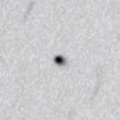
|
Now it is 16.0 mag (Dec. 12, J. Lozano). It is expected to brighten up to 7 mag in 2017 summer. In the Northern Hemisphere, it keeps observable in good condition until the highlight while the comet will be brightening. In the Southern Hemisphere, it is not observable until early 2017.
Date(TT) R.A. (2000) Decl. Delta r Elong. m1 Best Time(A, h)
Jan. 2 7 53.07 62 38.4 5.201 5.976 138 16.3 1:11 (180, 62)
Jan. 9 7 44.99 63 13.6 5.141 5.916 138 16.3 0:36 (180, 62)
|
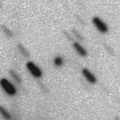
|
New comet. Now it is bright as 16.0 mag (Dec. 17, P. Bacci, L. Tesi, G. Fagioli). It keeps observable in good condition for a while.
Date(TT) R.A. (2000) Decl. Delta r Elong. m1 Best Time(A, h)
Jan. 2 5 44.26 17 20.8 2.477 3.434 164 16.3 22:58 ( 0, 72)
Jan. 9 5 40.55 16 26.1 2.519 3.443 156 16.4 22:27 ( 0, 71)
|
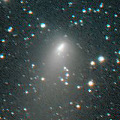
|
It brightened rapidly up to 10.4 mag from July to August (July 18, Maik Meyer). Now it is fading. It has already faded down to 16.0 mag (Dec. 8, Yasukazu Ikari). It is observable in good condition in the Northern Hemisphere. It is not observable in the Southern Hemisphere.
Date(TT) R.A. (2000) Decl. Delta r Elong. m1 Best Time(A, h)
Jan. 2 22 37.64 46 54.7 2.312 2.466 87 16.4 18:29 (124, 59)
Jan. 9 22 57.87 46 55.2 2.416 2.529 85 16.7 18:34 (124, 56)
|
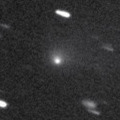
|
It brightened up to 14.5 mag in autumn (Nov. 11, Sandor Szabo). Now it is fading. It has already faded down to 16.7 mag (Dec. 14, L. Elenin). It will be fainter than 18 mag in March.
Date(TT) R.A. (2000) Decl. Delta r Elong. m1 Best Time(A, h)
Jan. 2 2 21.12 5 40.9 1.640 2.227 113 16.4 19:36 ( 0, 61)
Jan. 9 2 26.88 6 28.5 1.730 2.244 108 16.6 19:14 ( 0, 62)
|

|
Now it is 16.5 mag (Dec. 20, Michael Jager). It must have been observable at 16-17 mag in good condition from summer to autumn in the Northern Hemisphere, but it was not discovered. It will be observable after mid January also in the Southern Hemisphere. It will be fading after this, and will be fainter than 18 mag in April.
Date(TT) R.A. (2000) Decl. Delta r Elong. m1 Best Time(A, h)
Jan. 2 12 57.89 35 51.7 1.926 2.325 101 16.6 5:37 (261, 82)
Jan. 9 12 54.26 35 24.2 1.875 2.361 107 16.6 5:38 (252, 89)
|

|
Now it is 16.9 mag (Nov. 15, J. Bel). It will brighten up to 14 mag in summer. But it is not observable at the highlight. It keeps observable until March while the comet will be brightening gradually up to 15-16 mag.
Date(TT) R.A. (2000) Decl. Delta r Elong. m1 Best Time(A, h)
Jan. 2 0 36.68 -4 34.4 2.217 2.360 85 16.6 18:29 ( 15, 50)
Jan. 9 0 44.05 -3 37.9 2.277 2.333 80 16.6 18:34 ( 24, 49)
|
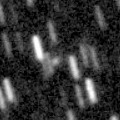
|
Now it is 17.0 mag (Nov. 3, A. Maury, J.-F. Soulier, J.-G. Bosch, T. Noel). It keeps 16.5 mag for a long time in 2016, and it will be observable in excellent condition in the Southern Hemisphere. It is hardly observable in the Northern Hemisphere.
Date(TT) R.A. (2000) Decl. Delta r Elong. m1 Best Time(A, h)
Jan. 2 6 41.32 -63 53.5 3.376 3.567 93 16.7 23:51 ( 0, -9)
Jan. 9 6 9.75 -64 12.6 3.364 3.547 92 16.6 22:53 ( 0, -9)
|
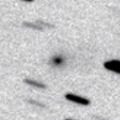
|
Now it is 16.8 mag (Dec. 18, Space Surveillance Telescope, Atom Site). It is observable at 16.5 mag in excellent condition from December to February. It locates somewhat low in the Southern Hemisphere.
Date(TT) R.A. (2000) Decl. Delta r Elong. m1 Best Time(A, h)
Jan. 2 8 35.51 19 42.2 1.004 1.938 154 16.7 1:53 ( 0, 75)
Jan. 9 8 33.19 20 35.1 0.985 1.945 162 16.7 1:23 ( 0, 75)
|
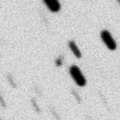
|
Now it is 16.9 mag (Dec. 13, K. Hills). It keeps 16-17 mag for a long time until 2016 autumn. In the Southern Hemisphere, it keeps observable in good condition for a long time. In the Northern Hemisphere, it is observable only until March.
Date(TT) R.A. (2000) Decl. Delta r Elong. m1 Best Time(A, h)
Jan. 2 4 20.02 -24 9.6 2.319 2.947 120 16.7 21:33 ( 0, 31)
Jan. 9 4 9.93 -25 25.7 2.357 2.901 114 16.7 20:56 ( 0, 30)
|
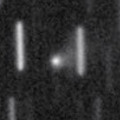
|
Brightening very rapidly, and it keeps brightening even after the perihelion passage. Now it is very bright as 15.9 mag (Dec. 16, Catalina Sky Survey). It keeps observable in excellent condition for a while.
Date(TT) R.A. (2000) Decl. Delta r Elong. m1 Best Time(A, h)
Jan. 2 5 54.75 -15 51.5 1.176 2.025 139 16.7 23:08 ( 0, 39)
Jan. 9 5 50.73 -15 19.3 1.224 2.055 136 16.9 22:37 ( 0, 40)
|
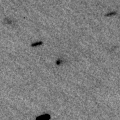
|
Now it is 16.9 mag (Nov. 17, J. Nicolas, C. Rinner, F. Kugel, A. Klotz). It will brighten up to 14 mag in 2017. In 2016, it keeps observable at 16 mag in good condition from winter to spring.
Date(TT) R.A. (2000) Decl. Delta r Elong. m1 Best Time(A, h)
Jan. 2 12 5.26 10 19.0 3.672 4.017 103 16.9 5:22 ( 0, 65)
Jan. 9 12 7.07 10 24.8 3.555 4.002 110 16.8 4:56 ( 0, 65)
|

|
Now it is 18.6 mag (Dec. 17, A. Klotz, F. Kugel, C. Rinner). It will be observable at 11 mag in good condition from spring to summer.
Date(TT) R.A. (2000) Decl. Delta r Elong. m1 Best Time(A, h)
Jan. 2 12 5.63 13 19.1 2.001 2.440 104 17.2 5:22 ( 0, 68)
Jan. 9 12 12.07 13 19.9 1.879 2.400 109 16.9 5:01 ( 0, 68)
|
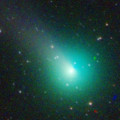
|
It brightened up to 6.0 mag in mid May (May 14, Chris Wyatt). Now it is fading. It has already faded down to 16.4 mag (Dec. 7, Yasukazu Ikari). In the Northern Hemisphere, it keeps observable in good condition after this while the comet will be fading. It locates somewhat low in the Southern Hemisphere.
Date(TT) R.A. (2000) Decl. Delta r Elong. m1 Best Time(A, h)
Jan. 2 5 55.68 38 29.2 2.493 3.438 161 16.9 23:08 (180, 86)
Jan. 9 5 38.69 38 33.0 2.612 3.518 153 17.1 22:24 (180, 86)
|
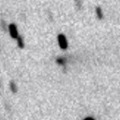
|
Now it is 17.0 mag (Dec. 16, Purple Mountain Observatory). It is observable at 17 mag in good condition in winter.
Date(TT) R.A. (2000) Decl. Delta r Elong. m1 Best Time(A, h)
Jan. 2 8 19.09 17 37.7 1.417 2.356 157 17.0 1:37 ( 0, 73)
Jan. 9 8 15.00 19 3.3 1.387 2.354 166 16.9 1:05 ( 0, 74)
|

|
It brightened up to 13 mag in 2014. Now it is 16.0 mag (Dec. 16, Yasukazu Ikari). It will be fading after this, and will be fainter than 18 mag in spring.
Date(TT) R.A. (2000) Decl. Delta r Elong. m1 Best Time(A, h)
Jan. 2 0 58.87 1 11.0 3.947 4.121 93 17.1 18:29 ( 7, 56)
Jan. 9 1 1.60 1 43.1 4.070 4.136 86 17.1 18:34 ( 20, 55)
|

|
Now it is 17.2 mag (Nov. 18, Catalina Sky Survey). Now it is near the aphelion. It is observable at 17 mag in good condition from autumn to winter.
Date(TT) R.A. (2000) Decl. Delta r Elong. m1 Best Time(A, h)
Jan. 2 3 8.43 15 7.2 3.548 4.225 128 17.3 20:23 ( 0, 70)
Jan. 9 3 7.32 15 12.5 3.629 4.217 120 17.3 19:54 ( 0, 70)
|
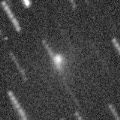
|
Now it is 16.9 mag (Dec. 16, Yasukazu Ikari). It wil be fainter than 18 mag in January.
Date(TT) R.A. (2000) Decl. Delta r Elong. m1 Best Time(A, h)
Jan. 2 1 26.36 32 46.3 1.922 2.441 110 17.3 18:41 ( 0, 88)
Jan. 9 1 32.07 29 4.7 2.064 2.486 103 17.5 18:34 ( 29, 83)
|

|
Now it is 19.6 mag (Dec. 14, K. Hills). It will brighten very rapidly and reach up to 11 mag in March. In this apparition, it keeps observable in excellent condition both brightening and fading period. In the Northern Hemisphere, it will be unobservable temporarily in mid March.
Date(TT) R.A. (2000) Decl. Delta r Elong. m1 Best Time(A, h)
Jan. 2 6 36.37 -9 41.2 0.467 1.399 147 17.8 23:49 ( 0, 45)
Jan. 9 6 29.18 -12 21.6 0.415 1.340 143 17.4 23:15 ( 0, 42)
|
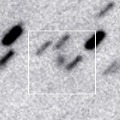
|
Now it is 16.9 mag (Dec. 19, Y. Sugiyama). It keeps 17.5 mag for a long time from 2016 to 2019. It keeps locating near by the equator.
Date(TT) R.A. (2000) Decl. Delta r Elong. m1 Best Time(A, h)
Jan. 2 8 11.11 -0 51.6 9.299 10.151 148 17.4 1:28 ( 0, 54)
Jan. 9 8 9.55 -0 44.4 9.246 10.138 153 17.4 0:59 ( 0, 54)
|

|
Now it is 17.5 mag (Dec. 17, Space Surveillance Telescope, Atom Site). It keeps observable at 17.5 mag in good condition from winter to spring in the Northern Hemispehre. It is observable only until mid February in the Southern Hemisphere.
Date(TT) R.A. (2000) Decl. Delta r Elong. m1 Best Time(A, h)
Jan. 2 8 13.30 17 20.2 1.771 2.712 158 17.6 1:31 ( 0, 72)
Jan. 9 8 1.06 21 7.4 1.696 2.669 169 17.4 0:52 ( 0, 76)
|

|
Now it is 18.3 mag (Nov. 15, Hidetaka Sato). It keeps observable at 17 mag in good condition from winter to spring.
Date(TT) R.A. (2000) Decl. Delta r Elong. m1 Best Time(A, h)
Jan. 2 14 9.63 3 46.0 2.603 2.493 72 17.5 5:37 (315, 50)
Jan. 9 14 19.67 3 15.8 2.526 2.496 76 17.5 5:38 (322, 52)
|
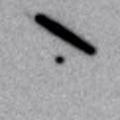
|
Now it is 17.1 mag (Dec. 13, D. Buczynski). It is observable in good condition in the Northern Hemisphere. It is not observable in the Southern Hemisphere.
Date(TT) R.A. (2000) Decl. Delta r Elong. m1 Best Time(A, h)
Jan. 2 11 36.75 47 51.8 1.566 2.210 118 17.5 4:54 (180, 77)
Jan. 9 11 34.06 49 15.1 1.565 2.260 123 17.5 4:23 (180, 76)
|

|
It has not been observed yet in this apparition. It tends to be brightest after the perihelion passage. It is observable at 17 mag in excellent condition until March in the Northern Hemisphere. It locates low in the Southern Hemisphere.
Date(TT) R.A. (2000) Decl. Delta r Elong. m1 Best Time(A, h)
Jan. 2 4 55.63 45 32.6 0.889 1.801 148 17.6 22:10 (180, 79)
Jan. 9 4 53.16 44 50.2 0.893 1.779 142 17.5 21:40 (180, 80)
|

|
Now it is 17.4 mag (Dec. 11, Purple Mountain Observatory). It will brighten up to 13 mag in summer. But it is not observable around the highlight. In the Southern Hemisphere, it is observable until February when it brightens up to 17 mag. In the Northern Hemisphere, it is observable until April when it brightens up to 16 mag.
Date(TT) R.A. (2000) Decl. Delta r Elong. m1 Best Time(A, h)
Jan. 2 1 52.94 11 5.5 2.923 3.379 109 17.6 19:07 ( 0, 66)
Jan. 9 1 53.50 10 54.8 2.956 3.308 102 17.5 18:40 ( 0, 66)
|
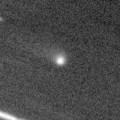
|
It brightened up to 16 mag in early 2015. Now it is 18.1 mag (Dec. 12, ATLAS-HKO, Haleakala). It is observable at 18 mag from winter to spring.
Date(TT) R.A. (2000) Decl. Delta r Elong. m1 Best Time(A, h)
Jan. 2 10 25.31 -24 28.0 5.545 5.937 108 17.7 3:42 ( 0, 30)
Jan. 9 10 18.78 -24 42.9 5.467 5.959 115 17.6 3:08 ( 0, 30)
|

|
It will pass the perihelion in 2019. However, it has not been brightening since the discovery in 2010. Now it is 17.6 mag (Dec. 3, D. Buczynski). It keeps observable in excellent condition from autumn to next spring in the Northern Hemisphere. It is not observable in the Southern Hemisphere.
Date(TT) R.A. (2000) Decl. Delta r Elong. m1 Best Time(A, h)
Jan. 2 3 13.06 47 34.3 10.084 10.757 131 17.7 20:27 (180, 77)
Jan. 9 3 11.19 47 26.8 10.136 10.733 125 17.7 19:58 (180, 78)
|
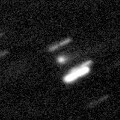
|
It brightened up to 15.2 mag in early 2015 (Feb. 24, Toshiyuki Takahashi). Now it is 17.5 mag (Dec. 6, Catalina Sky Survey). It will be fainter than 18 mag in April.
Date(TT) R.A. (2000) Decl. Delta r Elong. m1 Best Time(A, h)
Jan. 2 11 41.95 -5 41.8 4.359 4.672 102 17.7 4:59 ( 0, 49)
Jan. 9 11 42.86 -5 58.0 4.272 4.690 109 17.7 4:32 ( 0, 49)
|
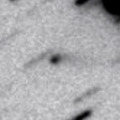
|
New comet. Now it is 17.6 mag (Dec. 17, A. Hidas). It keeps 17-18 mag for a long time until 2017 spring.
Date(TT) R.A. (2000) Decl. Delta r Elong. m1 Best Time(A, h)
Jan. 2 6 58.16 -28 17.3 3.427 4.113 128 17.8 0:16 ( 0, 27)
Jan. 9 6 53.65 -27 23.8 3.384 4.086 130 17.8 23:39 ( 0, 28)
|
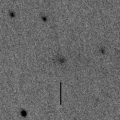
|
Now it is 17.7 mag (Nov. 30, Hidetaka Sato). It was expected to brighten up to 14 mag from winter to summer. But it is much fainter actually. It will be observable in excellent condition in the Southern Hemisphere. It locates low in the Northern Hemisphere.
Date(TT) R.A. (2000) Decl. Delta r Elong. m1 Best Time(A, h)
Jan. 2 14 24.75 -13 20.4 2.526 2.249 62 17.8 5:37 (323, 33)
Jan. 9 14 37.94 -15 5.3 2.455 2.244 66 17.9 5:38 (328, 34)
|

|
It keeps 17-18 mag for a long time since 2013. In the Northern Hemisphere, it is observable at 18 mag in good condition also in this winter. It is not observable in the Southern Hemisphere.
Date(TT) R.A. (2000) Decl. Delta r Elong. m1 Best Time(A, h)
Jan. 2 14 29.18 54 59.4 7.125 7.282 95 17.9 5:37 (218, 60)
Jan. 9 14 28.51 55 48.5 7.086 7.303 98 17.9 5:38 (212, 63)
|
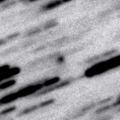
|
Now it is 16.8 mag (Dec. 19, Catalina Sky Survey). It keeps observable in good condition for a while. But it will be fainter than 18 mag in January.
Date(TT) R.A. (2000) Decl. Delta r Elong. m1 Best Time(A, h)
Jan. 2 3 33.28 24 4.9 2.137 2.923 135 17.9 20:47 ( 0, 79)
Jan. 9 3 32.90 23 43.7 2.238 2.953 128 18.1 20:20 ( 0, 79)
|

|
First return of a periodic comet which brightened up to 8 mag in major outburst in 2010. It will be observable in excellent condition from winter to spring. However, now it is so faint as 19.2 mag (Jan. 1, M. Schwartz, P. R. Holvorcem). It will be 18-19 mag at best in this apparition.
Date(TT) R.A. (2000) Decl. Delta r Elong. m1 Best Time(A, h)
Jan. 2 9 11.81 36 0.3 0.820 1.726 146 19.4 2:29 (180, 89)
Jan. 9 9 12.26 36 27.6 0.771 1.701 151 19.2 2:02 (180, 89)
|
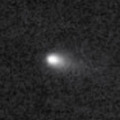
|
It brightened up to 15.9 mag in June as predicted (June 23, Ken-ichi Kadota). It was expected to be observable at 13 mag in good condition from summer to autumn. However, the comet became disintegrating in July. Now both the main component and fragment D are fainter than 20 mag.
Date(TT) R.A. (2000) Decl. Delta r Elong. m1 Best Time(A, h)
Jan. 2 2 14.55 10 14.4 1.558 2.154 114 21.3 19:29 ( 0, 65)
Jan. 9 2 21.10 11 14.9 1.667 2.192 108 21.5 19:08 ( 0, 66)
|
|
![]()
 67P/Churyumov-Gerasimenko
67P/Churyumov-Gerasimenko 29P/Schwassmann-Wachmann 1
29P/Schwassmann-Wachmann 1 230P/LINEAR
230P/LINEAR C/2011 KP36 ( Spacewatch )
C/2011 KP36 ( Spacewatch ) 249P/LINEAR
249P/LINEAR C/2014 W11 ( PanSTARRS )
C/2014 W11 ( PanSTARRS ) C/2013 V4 ( Catalina )
C/2013 V4 ( Catalina ) 329P/2015 T1 ( LINEAR-Catalina )
329P/2015 T1 ( LINEAR-Catalina ) 19P/Borrelly
19P/Borrelly C/2014 N3 ( NEOWISE )
C/2014 N3 ( NEOWISE ) C/2014 A4 ( SONEAR )
C/2014 A4 ( SONEAR ) 88P/Howell
88P/Howell 77P/Longmore
77P/Longmore 318P/2014 M6 ( McNaught-Hartley )
318P/2014 M6 ( McNaught-Hartley ) C/2006 S3 ( LONEOS )
C/2006 S3 ( LONEOS ) C/2015 V2 ( Johnson )
C/2015 V2 ( Johnson ) C/2015 X4 ( Elenin )
C/2015 X4 ( Elenin ) C/2015 F4 ( Jacques )
C/2015 F4 ( Jacques ) 61P/Shajn-Schaldach
61P/Shajn-Schaldach C/2015 YG1 ( NEOWISE )
C/2015 YG1 ( NEOWISE ) 118P/Shoemaker-Levy 4
118P/Shoemaker-Levy 4 C/2015 B2 ( PanSTARRS )
C/2015 B2 ( PanSTARRS ) 204P/LINEAR-NEAT
204P/LINEAR-NEAT C/2015 T4 ( PanSTARRS )
C/2015 T4 ( PanSTARRS ) P/2015 Q1 ( Scotti )
P/2015 Q1 ( Scotti ) 65P/Gunn
65P/Gunn 9P/Tempel 1
9P/Tempel 1 C/2015 G2 ( MASTER )
C/2015 G2 ( MASTER ) 211P/Hill
211P/Hill 117P/Helin-Roman-Alu 1
117P/Helin-Roman-Alu 1 74P/Smirnova-Chernykh
74P/Smirnova-Chernykh C/2015 GX ( PanSTARRS )
C/2015 GX ( PanSTARRS ) 252P/LINEAR
252P/LINEAR C/2014 B1 ( Schwartz )
C/2014 B1 ( Schwartz ) C/2015 W1 ( Gibbs )
C/2015 W1 ( Gibbs ) 180P/NEAT
180P/NEAT 162P/Siding Spring
162P/Siding Spring 194P/LINEAR
194P/LINEAR C/2015 TQ209 ( LINEAR )
C/2015 TQ209 ( LINEAR ) C/2013 G9 ( Tenagra )
C/2013 G9 ( Tenagra ) C/2010 U3 ( Boattini )
C/2010 U3 ( Boattini ) 269P/2012 R2 ( Jedicke )
269P/2012 R2 ( Jedicke ) C/2015 X7 ( ATLAS )
C/2015 X7 ( ATLAS ) C/2014 Y1 ( PanSTARRS )
C/2014 Y1 ( PanSTARRS ) C/2012 K8 ( Lemmon )
C/2012 K8 ( Lemmon ) 44P/Reinmuth 2
44P/Reinmuth 2 331P/2015 Y2 ( Ikeya-Murakami )
331P/2015 Y2 ( Ikeya-Murakami ) 51P/Harrington
51P/Harrington![]()




















































